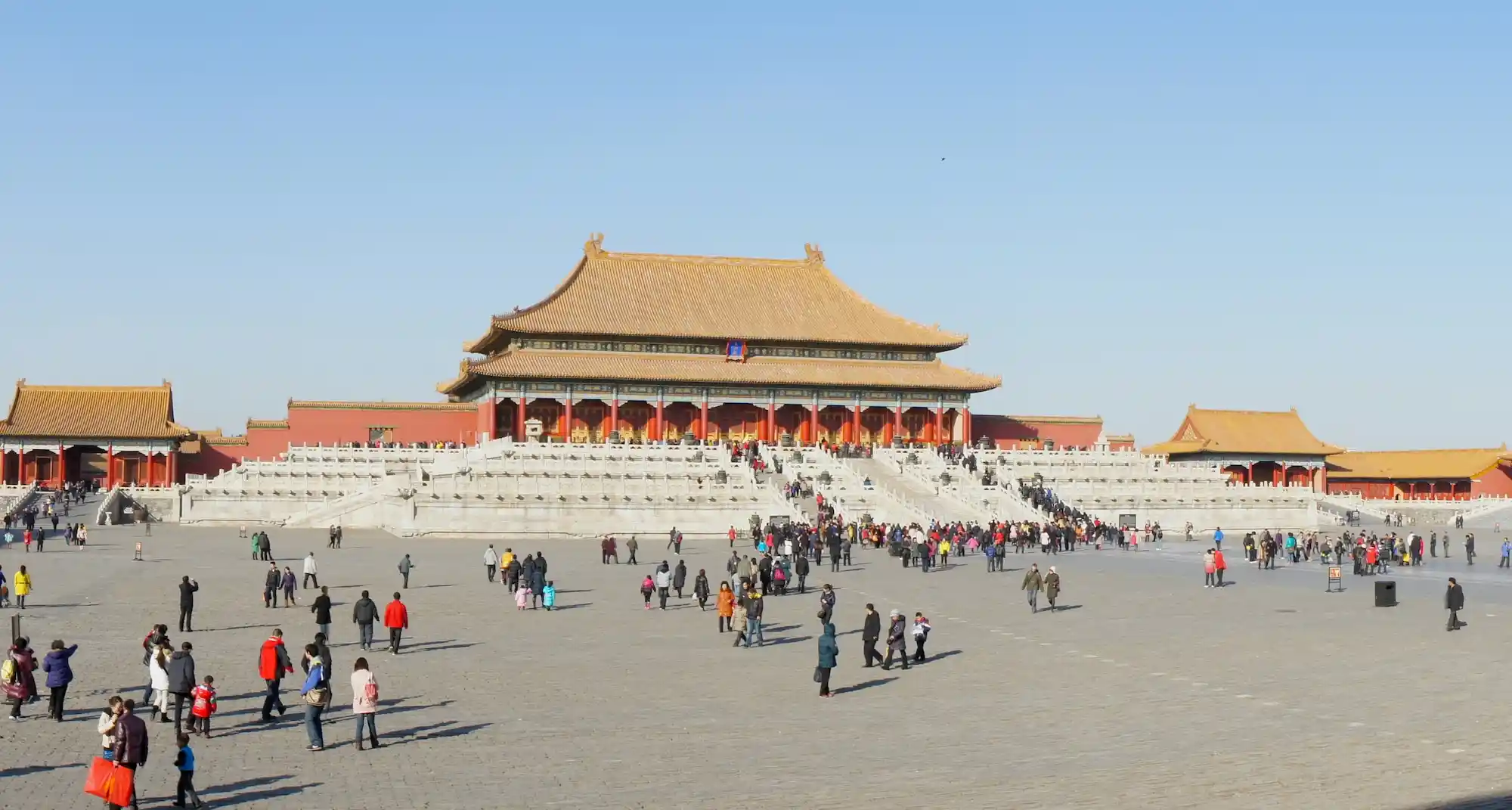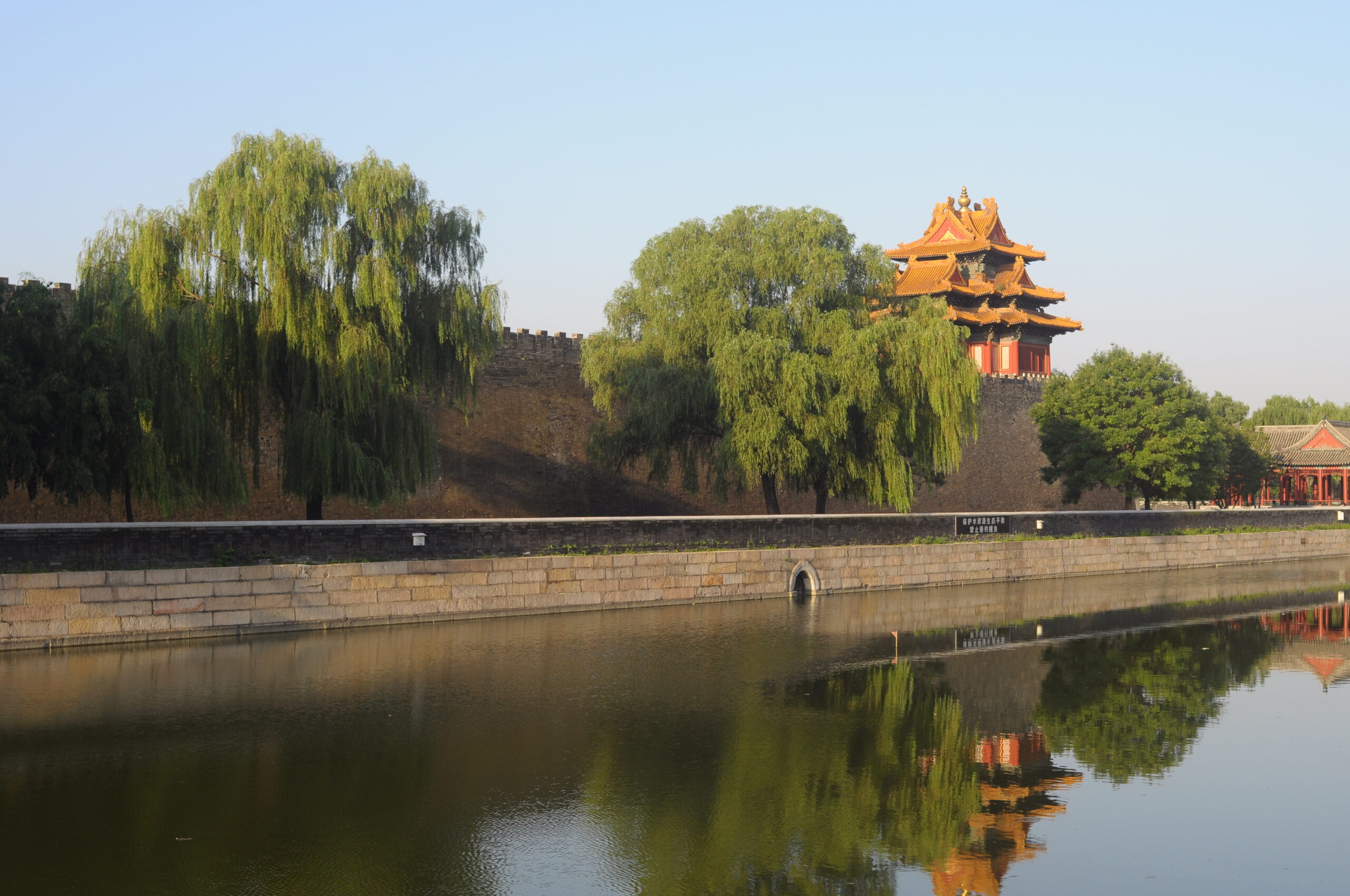
In the center of Beijing (北京), the capital of China, stands one of the world’s most impressive architectural jewels: the Forbidden City (Zijin Cheng, 紫禁城). This impressive palace complex, a symbol of Chinese imperial power for almost five centuries, continues to fascinate millions of visitors who cross its imposing crimson walls to enter a world of mystery and splendor.
Strategic Location in the Heart of Beijing
The Forbidden City is located in the exact center of Beijing, north of the emblematic Tiananmen Square (Tiananmen Guangchang, 天安门广场). This location is not coincidental but follows ancient Chinese urban planning based on cosmological principles. The palace is perfectly aligned with the north-south axis of the city, reflecting the traditional belief that the emperor, as the “Son of Heaven” (Tianzi, 天子), should reside at the central point of the empire, connecting heaven and earth.
Origins and Foundation: The Legacy of the Ming Dynasty

Construction of this colossal palace began in 1406 under the command of Emperor Yongle (Yongle Huangdi, 永乐皇帝), the third emperor of the Ming dynasty. After moving the capital from Nanjing (南京) to Beijing, Yongle ordered the construction of a palace that would reflect the greatness of his empire. More than a million workers and artisans participated in this titanic endeavor, which was completed in 1420 after fourteen years of intense work.
Legend has it that to ensure the palace’s perfection, knowledge from the best feng shui (风水) experts was employed, the ancient Chinese science of spatial harmony. Every architectural detail, from the orientation of buildings to the arrangement of courtyards, was meticulously calculated to create a perfect balance between man and nature.
Dimensions and Structure: A City Within a City

With an area of 72 hectares, the Forbidden City is the largest preserved palace complex in the world. Its 980 buildings house more than 8,700 rooms, surrounded by a 10-meter high wall and a 52-meter wide moat that served as a defensive system.
The complex is divided into two main areas: the Outer Court (Wai Chao, 外朝), where the emperor exercised his official functions and held state ceremonies, and the Inner Court (Nei Ting, 内庭), reserved for the emperor’s residence and his family. This spatial division reflects the strict separation between public affairs and imperial private life.
The perfect symmetry of the complex is structured around a central axis that connects the main ceremonial halls: the Hall of Supreme Harmony (Taihe Dian, 太和殿), the Hall of Central Harmony (Zhonghe Dian, 中和殿), and the Hall of Preserved Harmony (Baohe Dian, 保和殿). These majestic buildings, elevated on white marble terraces and crowned with golden tile roofs, constituted the setting for the most important events in the empire.
The Heart of Chinese Imperial Power

For almost five centuries, from 1420 to 1911, the Forbidden City was the nerve center of power in China. Twenty-four emperors, fourteen from the Ming dynasty and ten from the Qing dynasty, ruled from this sacred precinct, inaccessible to common citizens. Hence its name, “forbidden” to all except the imperial family and high officials who received special authorization.
The palace was not simply a residence, but a microcosm representing the universal order according to Chinese cosmology. The emperor, considered an intermediary between heaven and earth, inhabited this sacred space from which emanated decisions affecting the entire empire. Daily rituals, imperial audiences, and grand ceremonies followed a rigid protocol that reinforced the sovereign’s authority.
In the intricate corridors and secret gardens of the Forbidden City, alliances, conspiracies, and romances were forged that changed the course of Chinese history. Figures such as the powerful Empress Dowager Cixi (Cixi Taihou, 慈禧太后), who ruled from the shadows during the last decades of the Qing dynasty, left their mark on every corner of the palace.
The Decline of an Empire: From Imperial Palace to Museum

The end of the Forbidden City as an imperial residence came with the abdication of the last emperor, Puyi (溥仪), in 1912, following the success of the Xinhai Revolution (Xinhai Geming, 辛亥革命) that ended more than two millennia of imperial system in China. Although the young emperor was allowed to continue living in the northern part of the palace until 1924, the era of emperors had definitely ended.
In 1925, the former imperial palace opened its doors as a museum, revealing to the world artistic and cultural treasures accumulated over centuries. Today, the Palace Museum (Gugong Bowuyuan, 故宫博物院) houses more than a million valuable pieces, from silk paintings and calligraphy to jade, porcelain, bronze objects, and historical documents that narrate the fascinating history of China.
Declared a World Heritage Site by UNESCO in 1987, the Forbidden City is now one of the most visited monuments in the world. Its silent courtyards, labyrinthine corridors, and majestic halls continue to whisper the stories of a time when emperors ruled the “Middle Kingdom” (Zhongguo, 中国) from this magnificent palace.
How to Visit The Forbidden City of Beijing
Visiting The Forbidden City of Beijing requires at least half a day. Dedicate a full day if you want to add visits to the surrounding areas such as Tiananmen Square (天安門廣場), also known as the Gate of Heavenly Peace Square, or Jingshan Park (景山公園) and Beihai Park (北海公園) which are just north of the palace, only a 10-minute walk from the exit.
You can visit The Forbidden City at a leisurely pace, in two or three hours, or in express mode in approximately one hour, not counting travel time to get there. The complex is enormous, so we recommend comfortable footwear for walking a lot on your visit day.
If you’re not in a rush, we strongly recommend renting an audio guide; it will help you understand the different areas of the palace since there aren’t many explanations on signs.
The palace has bathrooms and a café, but if you visit in summer, we recommend bringing water as the temperature can be very high in its courtyards. Also add a hat or individual umbrella as locals do to protect yourself from direct sunlight.
Keep in mind that for several years now, it has been necessary to purchase palace tickets in advance, and although there are ticket windows, it’s not always possible to buy them on the same day.
After visiting the Forbidden City, we recommend, if you still have energy in your legs, climbing to the top of the hill in Jingshan Park. You’ll see it right as you exit the palace. The views of The Forbidden City from the top of the park will leave you speechless.
Finally, we recommend the movie “The Last Emperor” (1987) by Bernardo Bertolucci, winner of 9 Academy Awards. It was the first Western film shot inside the palace and featured Puyi’s own brother, Pujie, in its production.
Are you ready to discover China?
At Asiahop, we can design a tailor-made trip to China that fits your interests, time, and budget. Contact us for a personalized trip plan to China and start planning your adventure through the fascinating country known as “The Middle Kingdom” (中国).